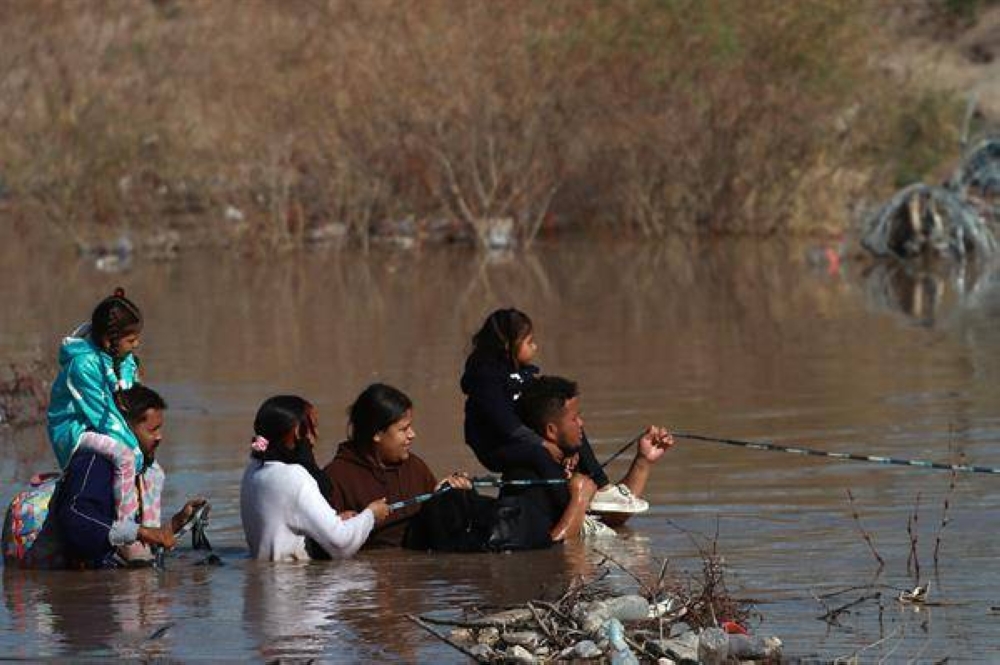Water release into Rio Grande increases risk for migrants at Mexico-U.S. border
Migrants cross the Rio Grande River, the border separating Mexico and the United States, on March 14, 2024, in Ciudad Juarez, Mexico. /EFE Migrants crossing the border are facing new dangers as the U.S. begins discharging Mexico's worth of water into the Rio Grande under treaty terms, as they struggle… The United States has begun pumping Mexico's worth of water into the Rio Grande under treaty terms, causing a surge in migrants as they struggle with the flow and the razor-wire fence that the Texas government refuses to remove. The heightened risk is exacerbated by a 10-foot-tall barbed wire and razor wire fence that Texas Gov. Greg Abbott has refused to remove despite a U.S. Supreme Court order. The Mexican government claims this puts migrants at increased risk of injury or death while crossing, as seen in the January 14 drowning of a Mexican woman and her two children in Piedras Negras. A bilateral water treaty signed in 1944 allows the United States to supply water to Mexico through the Rio Rio Grande water from dams in southern New Mexico.

ที่ตีพิมพ์ : หนึ่งปีที่แล้ว โดย Adrian ใน World
Migrants crossing the border are facing new dangers as the U.S. begins discharging Mexico’s worth of water into the Rio Grande under treaty terms, as they struggle with the flow and the razor-wire fence that the Texas government refuses to remove. trapped in between.
The United States this week began pumping millions of cubic meters of water into border tributaries mandated by the Bilateral International Water Distribution Treaty, but the increased flow has caused a surge in migrants, as recorded by the EFE in Ciudad Juárez, which borders El. risks are increasing. Paso, Texas.
Migrants use empty water jugs as river floats, while others carry their children on rag ropes over their shoulders as the only safety net.
Rafael Cortez, a migrant from El Salvador, stopped at the Mexican coast wondering whether to cross due to slow currents, but local authorities have warned of the dangers.
“The truth is that it is dangerous to cross paths like that. There is a risk of deportation and so on,” the Central American told EFE.
The siege of Texas exacerbates the danger.
The danger is exacerbated by a 10-foot-tall barbed wire and razor-wire fence that Texas Gov. Greg Abbott, a Republican, has refused to remove despite a U.S. Supreme Court order in January. There is.
The Mexican government says this puts migrants at increased risk of injury or death while crossing, as in the January 14 drowning of a Mexican woman and her two children in Piedras Negras. did.
Now, with the rising waters of the Bravo River, the space of land between the river and the razor wire fence has been reduced to less than a meter.
Once across the tributary, the migrants become trapped between the current and the razor, waiting to cross the fence and avoid the Texas National Guard.
But El Salvador’s Cortés said he had no choice because “we have been waiting for the CPB One appointment (application for appointment to the U.S. authorities) for four months and nothing has come out.”
“So we took the alternative of crossing paths with my nephew like this and letting him do what God wants him to do. It’s a little deeper so we’ll have to see what we do. So let’s see what happens,” he said. It’s over,” he added.
Wendy, a Venezuelan migrant, has already decided to cross despite the dangers, tearfully saying her biggest fear is not coming from the final barrier.
“I’m worried that if I go through something like this, I won’t be accepted and I’m at risk of being returned,” he says. “We have been through a lot in Venezuela, but we passed through the jungles of Darien. The roads are even more dangerous,” he added.
A bilateral water treaty signed in 1944 provides for the United States to supply water to Mexico through the Rio Grande water from the U.S. dams El Caballo and El Elefante in southern New Mexico.
Before the deliveries began, the depth of the river in front of Point 36 on the Juarez-El Paso border increased from less than a meter to almost two meters, forcing migrants to swim.
These events come amid unprecedented migration flows in the region in recent years, with Mexico expected to see a nearly 77% increase in illegal immigration in 2023, with more than 782,000 undocumented aliens discovered. It is reported that.
Additionally, the International Organization for Migration (IOM) announced in September last year that the border between Mexico and the United States is the “world’s most dangerous land migration route,” with more than 686 migrants expected to die or go missing in 2022. he declared.
